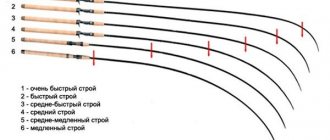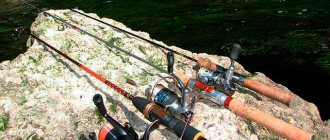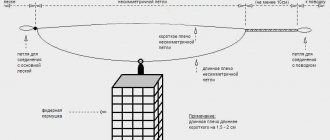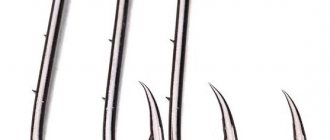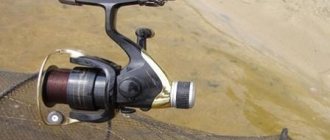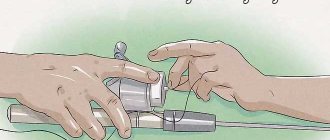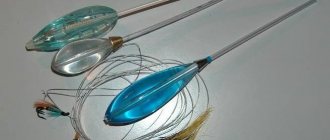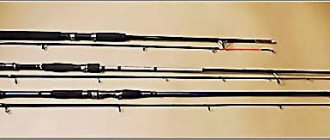Those anglers who are familiar with fly fishing will never argue that fly rods are the most important element in the equipment of a lover of this type of fishing. This is one of the least common types of fishing in our country, but it is very exciting, although quite labor-intensive.
The fisherman constantly has to move around and cast bait into the most promising places in the reservoir. Therefore, a fly fishing rod must suit both the fly angler's preferences and the conditions in which the fish is being fished.
Fly fishing
Many fish (trout, taimen, grayling, chub and others) get their food from the surface of the reservoir or in the near-surface layer. Casting and keeping bait on the surface with traditional gear is quite a difficult task.
This bait is too light for ordinary tackle. Even a weak breeze easily blows it away at the moment of casting. Fish in the near-surface layer see well and at the same time stand against the current in the river. The bait has to be supplied in such a way that it is carried by the current to the fish sites, while the fisherman remains unnoticed. Difficult task. It is incredibly difficult to achieve this with ordinary tackle, even with a fair wind.
Therefore, the trendsetters of fishing fashion, the British, came up with a fishing method in which the bait is fed to the required distance not due to the weight of the bait, but due to the properties of the elastic cord used in the equipment instead of fishing line. The experience of the British was used by the Americans, who are currently leaders in this method of fishing and most of the new products associated with fly fishing appear in Europe from America.
This method of fishing is called fly fishing. It is widely used in fishing on cold, fast-moving rivers, usually with a rocky bottom and shallow depth. In addition, fly fishing has taken root in fishing (for the same trout) in lakes, mangrove forests, coral reefs, and in the tropical forests of Asia, Africa and America.
Of course, modern fly fishing as a fishing method is seriously different from the one with which the British began. Much has changed in fisherman's equipment since those times, but the basic elements have remained the same.
Fly fishing kits - ideal for beginners
The fly fishing kits include: a DVD with detailed instructions on all the details associated with fly fishing, a knotter, a box for flies and various other accessories.
What's so good about these sets? Firstly, these complete fly fishing kits include all the most important items. You don't have to rack your brains about what else to buy. Secondly, this is the price of the kit. It is accessible to any beginner. It often happens that a certain item in a purchased set is cheaper than the same item purchased separately from the set. Another advantage of such sets is that when you buy, you get a fully balanced and functional tackle, which you can use to catch fish no less than the tackle for which you pay tens of times more.
Not to be confused with fly fishing tool kits, which contain a fly tying rig and other useful fly fishing tools and are suitable for more advanced fly fishermen.
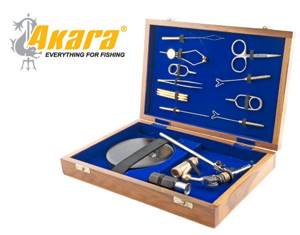
Akara Fly Fishing Tool Set.
Material
This is a special type of fishing rod. Such fishing rods are made from the following materials:
- Fiberglass;
- Carbon fiber materials (modified carbon);
- Glued bamboo.
Fishing rods made of fiberglass are durable, flexible and quite affordable in price. This material has one significant drawback - its own weight. Fiberglass rods are heavy. A fisherman who has to almost constantly re-throw his tackle gets tired very quickly. Therefore, these days such rods are used mainly in sea fishing, in cases where power and reliability are required from the rod.
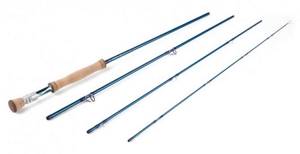
Carbon fiber rods are flexible and durable. They cost more than fiberglass rods. But they weigh much lighter. A fisherman can make many more casts without the slightest sign of fatigue. The disadvantages of this material are:
- high electrical conductivity (carbon fiber fishing rods are dangerous to use during thunderstorms and to fish under power lines);
- the need for constant preventative maintenance of the rod after fishing.
But these shortcomings more than pay off when fishing. Currently, most manufacturers produce fly fishing rods from carbon fiber.
Glued bamboo is an elite material. A wealthy professional fly fisherman can be identified by his fishing rod.
The very first fly fishing rods were made from laminated bamboo. These fishing rods are made by hand. During the production process, only high-quality varieties of bamboo are used, which are selected and polished exclusively by hand. This rod is quite expensive. And until now, bamboo rods are considered the elite fishing rods for this method of fishing, although they are difficult to operate and maintain.
CAPACITY FUNCTION.
What is a fly fishing reel as a “capacity”. Naturally, a reel of a certain class must accommodate a corresponding class of cord and a certain amount of extension backing. With the cord, everything is more or less clear, but with the backing... As a rule, all reel manufacturers, in their output data, indicate the capacity on the spool of 3...4 similar classes of cord and extension backing. The higher the cord class, the less backing. However, if for small reels (up to 3...4 classes), which are used, as a rule, when fishing for small grayling, brook trout... in small streams and rivers, there is no need for a large supply of backing, then for medium reels (5...8 ) and, especially, a large class (9...14), the presence of a large supply of backing is now considered absolutely necessary. Backing reserves of 150 - 200 m are now considered mandatory for such reels, and some manufacturing companies, such as Abel, Tibor, Loop..., which produce specialized heavy-duty reels for salmon fishing and sea fishing, create reels that allow you to have a backup reserve up to 300 - 400 m. This is understandable. Imagine yourself in a situation in which the “Hemingway old man” found himself and with a 30-40 meter piece of backing on the spool.
But this is not the only thing that exhausts the “capacitance function” of the coil. The container must be a reliable container for the cord and backing and must not deform or damage them. Therefore, almost all reputable companies continue to work on the search and creation of special corrosion-resistant materials and coatings that prevent damage to cords. Typically, spools and reel frames are made of light aluminum alloys coated with anode films. Particular attention is paid to the quality and wear resistance of the surface of the “windows” of the frame, through which the cord is pulled when working with it during the casting process. Some, “Abu Garsia”..., install roller or horn protectors, chrome-plated or ceramic, in the “windows” (see Fig. 1). Most companies do not install such protectors at all, but appropriately round and profile the edges of the frame in the area where the cord exits, which significantly increases the area of contact between the cord and the frame and, accordingly, reduces contact stresses and the likelihood of damage to the cord. The quality of the surface, anti-corrosion and anti-friction coatings of many well-known companies, such as Orvis (certain models (see Fig. 2)), Tibor (almost all), Henchel (see Fig. 3) ... inspires admiration and confidence in the quality and reliability of the reel . Many companies are searching and working in this direction.
| We foresee that soon in the arsenal of many companies there will be reels with “ceramic” coating of surfaces, high hardness and wear resistance. In the field of high technology, such coatings have long been known, but they are still quite expensive and their appearance sometimes conflicts with the function of a “fashionable toy.” We will return to this issue later. |
Features of fly fishing rods
Fly fishing rods are always composite. They consist of two or four knees. The method of connecting them is plug-in. There are two types of such connections:
- The upper elbow is inserted into the lower one;
- The lower elbow is inserted into the upper one;
Which one should you prefer? A non-professional will not notice much of a difference. Matter of habit.
The fly fishing rod equipment includes:
- pass rings;
- reel seat;
- handle;
Passage rings (from 5 to 11 pieces) are always made of metal. For sea fishing, this metal undergoes additional anti-corrosion treatment in the factory. A fly fishing rod can be equipped with different types of guides, from the traditional “snake” to regular rings (on one leg) with or without liners.
The reel seat is located almost on the butt of the rod. This type of placement is necessary for better balance of the rod. This is the main difference between a fly fishing rod and all other rods. For novice fishermen, the type of reel mount does not matter much.
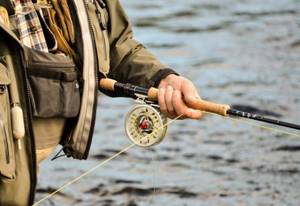
The handle of this type of fishing rod is short, made of different materials, the main property of which is a low slip coefficient.
Differences between fly fishing forms
Externally, fly fishing rods can be similar to the usual spinning rods or float rods. But at the same time, in the right fly fishing gear, some characteristics are especially important, which in the same spinning rod do not play a key role. So the light weight and lack of resistance of the cord when casting are put in first place. Another very important factor is wear resistance. During the fishing process, gear is exposed to extreme environmental conditions: the reel and blank are lowered into the water, dropped on the sand, and in some cases, fly fishing can even be carried out in pouring rain.
Therefore, manufacturers pay a lot of attention to protecting gear from moisture and dust. They cover it with waterproof varnish, make the coils from materials resistant to corrosion and friction, and minimize the gaps.
Also, such tackle differs from conventional fishing rods not only in characteristics, but also in structure. Their main difference is that the coil is located almost at the very end. This is done for convenient interaction with the cord. The handles themselves can also be of different shapes. In rods designed for catching large fish, there is a thumb rest on top, and when fishing for small fish, the index finger is placed on top for a more comfortable grip.
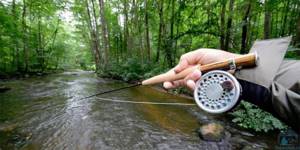
Example of fly fishing gear
Rod classes
All fly fishing rods are divided into classes:
- rods of classes 0 – 2 are short (length from 1.8 to 2.1 meters) and very light. They are designed for catching small trout and chub on small rivers. In combination with these rods, the smallest and lightest baits are used (dry, wet and slightly loaded nymphs and flies). The characteristics of such rods do not allow long casts.
- Rods of classes 3 – 4 with a length of 2.1 to 2.7 meters are also quite light. Due to the length of the rod, it is possible to cast bait at distances of over 10 meters. Dry and wet flies, as well as loaded nymphs, can be used as bait.
Rods of classes 0 to 4 are recommended for beginner fly fishers. With their help, you can learn how to cast bait, how to retrieve it and control it.
- Rods of 5-6 classes are the most popular fishing rods for those who already have basic skills in working with heavier baits. Rods of these classes have a length of 2.6 - 2.8 m, they allow you to serve medium-sized bait (all types of flies, loaded nymphs and streamers up to 6 cm long) at a distance of up to 20 m. With such a fishing rod you can go out to medium-width rivers and fish fish weighing more than 2 kg.
- Rods of 7-9 classes are used for catching large fish (like taimen and salmon) in fairly wide bodies of water. The length of such a fishing rod can reach 4.5 meters. The rigging of such a rod usually uses heavy baits (heavy flies and streamers). Casting can be done at a distance of up to 30 meters. Sometimes such rods are used in catching sea predators.
- Rods of 10 – 12 classes are used only in sea fishing. They are characterized by long range, increased strength and flexibility.
indicator of fly fishing rods is considered decisive in the selection of a suitable fishing rod.
Classification of fly fishing forms
The first thing a novice angler who wants to buy a fly fishing rod encounters is the classification system for this type of gear. In some sources it may be described in a complex and unclear way. In fact, all you need to know when choosing a fly blank is:
- Class
- Build
- Material from which the tackle is made
- Rod length
- Is it one-handed or two-handed?
More details about which characteristics influence what, and how to choose gear suitable for fishing in specific conditions will be discussed below.
One-handed
Single-handed fly rods are more common among anglers new to fly fishing because they make casting techniques easier to understand. One-handed tackles are shorter and lighter, making them more convenient to use in such conditions. But this does not mean that the skill of an angler depends on whether he uses a two-handed fly rod or not. Both types show good results in different conditions. It will just be easier for a beginner to handle a lighter form.
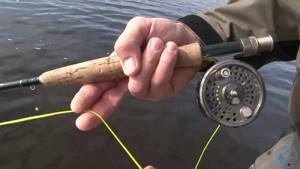
One-handed
Two-handed
Two-handed ones are designed for catching large fish, so their length and strength are greater than those of one-handed ones. Due to the size of the fishing rod, a beginner may have problems using it. It will be especially difficult to cope with it in a confined space (in small bodies of water, overgrown on all sides with trees, bushes and other vegetation). Therefore, if there are no open bodies of water nearby where you can safely practice casting bait, then it is better not to take a two-handed one.
Another difference between two-handed ones is that they allow casting over longer distances. The second hand at the moment of casting the bait will more accurately control the movement and provide more force.
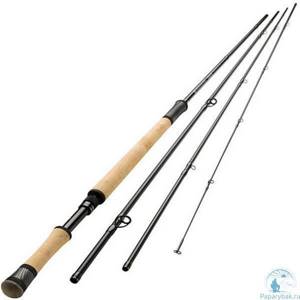
Two-handed fly fishing
Fly fishing gear
When choosing fly fishing gear there should not be such a division as a fishing rod for beginners and a professional tool.
To get a proper understanding of the operation and effectiveness of fly fishing, you need to start with the right gear, comfortable and balanced. Nowadays, a ready-made set can be purchased in a store, but it is better to assemble fly fishing tackle for beginners yourself. This will allow you to study all its technical subtleties.
So, how do you assemble your fly fishing gear?
When purchasing, it is also important to pay attention to the pass rings. If they are deformed or have chips on the inner surface, it is better not to take such a rod.
As a rule, these are two-handed products, the weight of which does not allow you to fish with them for a long time.
Coil. This element of gear should be light and small-sized, or even better, miniature.
Fly fishing reels are made from ultra-light alloys and very durable plastic. Usually the weight of such a product does not even reach 100 g, so it does not weigh down the tackle at all, which is one of the main conditions for such fishing.
You can use both inertia-free models and more reliable multiplier ones. Each of these options has its own pros and cons, so when choosing, fishermen are often guided by their own preferences.
Cord. For fly fishing you will need an expensive high-quality line, but options are possible.
For example, if you don’t have enough money for an expensive braid, you can install a regular cord with a cross-section of up to 0.3 mm, having previously lubricated it along its entire length with goose fat or some similar substance.
The fly fishing line must be heavy enough and at the same time float. To maintain buoyancy for as long as possible, its surface is treated with a special aerosol.
Backing. This term refers to an additional piece of lower quality braided or monofilament line that is added to the end of the main line and wound onto the spool first. Thanks to this addition, the cost of collecting gear is significantly reduced.
Undergrowth. Any fly fishing gear uses a leader (leader) made of monofilament or conical braid, which is a continuation of the main line. The difference in the diameters of its ends ensures that the bait falls smoothly onto the water.
Connector. A part that performs an important function. It connects the main cord to the undergrowth. Now cords with factory loops have appeared on sale, but practice has shown that they sometimes fail. It is for this reason that most fly fishermen prefer to make their own connector.
And here’s what you need to know: Do-it-yourself bait for bream, bait for bream in the spring
Leash. A thin and strong monofilament line with a length slightly shorter than the rod and a diameter of up to 0.25 mm. In different conditions, it is preferable to use a fishing line of a certain shade for a leash. For example, on an overgrown lake it is greenish.
Front sights. Artificial flies are most often used in fly fishing. On an unfamiliar body of water, it is quite difficult to guess the catchable color and shape of the bait; choosing an effective model can only be done during the fishing process. For this purpose, fishermen sacrifice the first fish they catch: they open its belly and examine the contents of the stomach.
One of the most crucial moments is the choice of fly fishing gear. It consists of the following main elements:
- blank (rod)
- coil
- cord
- underbrush and bait
With this set of fishing accessories you can begin to get acquainted with fly fishing.
Additional details you will need later:
- floats and connectors
- carabiners and leashes
It is important to assemble such a fishing rod so that it is comfortable and obedient in the hands of a novice fisherman.
Rod
Fly fishing rods or blanks are usually divided into classes. As the class increases, the strength of the blank increases, and the rod is able to withstand greater loads.
It is best to take your first steps in fly fishing with a 6-7 class fishing rod. Its strength is enough for both 200 gram grayling and 4 kilogram lenok.
Two-piece models are more reliable because they have fewer connections, which reduces the number of breakdowns.
Four-piece fishing rods have the advantage of being longer. The form can be made from different materials:
- bamboo
- fiberglass
- carbon fiber
You can successfully fish with a rod made of any material, as long as it is not too flexible.
Particular attention must be paid to the handle. If the material used is leather or rubber, then it is better to refuse such a fishing rod. Only a cork handle is worthy of consideration for fly fishing.
Coil
Fly fishing reels are divided into three types:
- automatic
- cartoon
- ordinary
For a beginner fly fisherman, an ordinary model with an adjustable brake is suitable. The brake can be quiet or equipped with a ratchet. It is important that when the brake is in the tightened position, the cord does not come loose from the drum when tugging strongly on it. The weight of the reel should not exceed the weight of the fishing rod.
The reel drum should accommodate 30-60 m of 0.4 mm diameter extension line under the fly line. The optimal volume of fishing line will be such that the cord does not rub against the edges of the reel when wound.
And here's what you need to know: Rigging a float rod for crucian carp - all the secrets and methods
Fly line
Along with the rod, fly line is the most expensive part of the tackle. This is explained both by its special parameters and rapid wear even with careful use. During active fishing, you have to change the line twice during the season.
The store may offer a sinking or floating option. With a floating model, it will be easier for a beginner to cast the equipment.
As for the class of the cord, it must correspond to the class of the fishing rod. Therefore, the optimal solution would be to purchase grade 6-7. Of all the colors, it is best to give preference to a white cord, which is most visible in the water.
After training on the shore or after fishing in dirty water, you should clean the cord with a special product, which is sometimes included in the box.
Leader or leash
A fishing line with a reducing diameter is used as a leader in fly fishing gear. For a beginner, the best option would be a taper of 0.5 mm to 0.2 mm. The thick end of the leash is tied to the cord, and the fly is mounted on the thin end of the fishing line.
The diameter of the undergrowth should be thinned as follows:
- 0.5 mm length 125 cm
- 0.45, 0.4, 0.35, 0.3 and 0.25 mm, 15 cm long
- 0.2 mm length 60 cm
The total length of the leash will be 2.6 m. If the length of the rod is less than this figure, then it is necessary to shorten the section with a thickness of 0.5 mm. In strong winds it is more convenient to use short undergrowth. Therefore, you should prepare several leashes of different lengths in advance.
It is imperative to check the condition of the fishing line on the leash after a series of casts for any knots. They reduce the strength of the fishing line, so such undergrowth must be replaced immediately.

